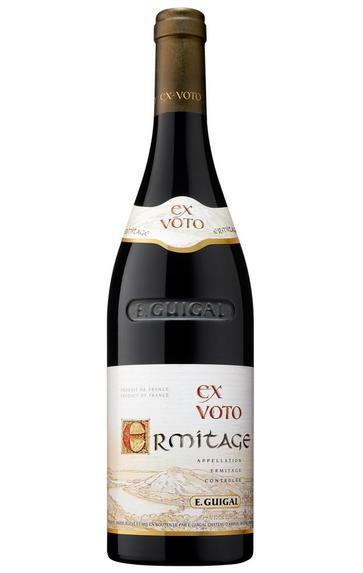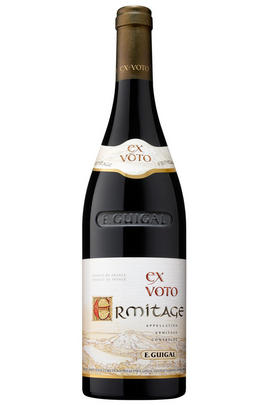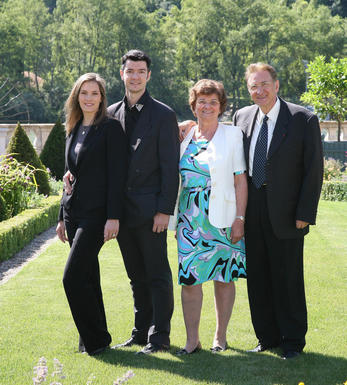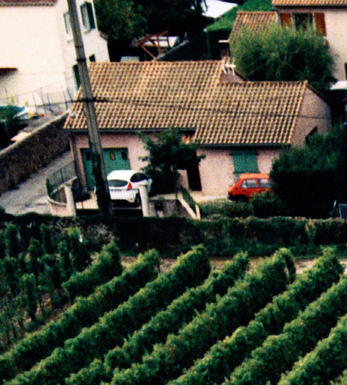
2015 Ermitage Rouge, Ex Voto, E. Guigal, Rhône

Critics reviews
Deep, glass-staining ruby. Deep-pitched aromas of cherry liqueur, blackberry, fruitcake and incense on the highly perfumed nose. Stains the palate with vibrant black and blue fruit liqueur, allspice and violet pastille flavors, enlivened by a smoky mineral nuance that builds with aeration. Shows a suave blend of richness and vivacity, and no rough edges. Spicy and expansive on the strikingly long, sappy finish, which features resonating dark berry character and youthfully chewy tannins.
Drink 2026 - 2038
Josh Raynolds, Vinous.com (April 2020)
Spicy, cedary and firm, the 2015 Ermitage Ex Voto is built tough, like the granite it comes from. Hints of pencil shavings and crushed stone accent mixed red and black fruit, picking up hints of licorice and pepper on the long, tannic finish. Give this another 5-6 years in the cellar, then drink it over the following decade and a half or so.
Drink 2025 - 2040
Joe Czerwinski, Wine Advocate (December 2019)
About this WINE

Maison Guigal
Guigal is the most famous produer in Côte Rôtie and one of the finest in the Rhône Valley. It was founded in 1946 by Etienne Guigal, following his departure from Vidal-Fleury, where he had worked for just under twenty years. His son, Marcel, joined the company in 1961 and is now the head of the company.
Guigal pioneered the notion of single vineyard Côte Rôties and his 3 most famous wines, La Landonne, La Mouline and La Turque are amongst the most sought after wines in the world today.
Marcel Guigal's attitude to winemaking is typical of the simple genius that one seems to stumble upon when looking at any of the world's greatest winemakers - low yields, organic viticulture and little or no intervention in the cellars - in short, a respect for nature and a passion for the wine itself.
Robert Parker commented on Marcel Guigal that "In the past 20 years I have spent visiting wineries and vignerons, I have never seen a producer so fanatical about quality as Marcel Guigal."

Hermitage
Hermitage is the most famous of all the northern Rhône appellations. The hill of Hermitage is situated above the town of Tain and overlooks the town of Tournon, just across the river. Hermitage has 120 hectares and produces tiny quantities of very long-lived reds.
The vines were grown in Roman times, although local folklore claims their origins to be nearly 600 years earlier. The name ‘Hermitage’ first appeared in the 16th century, derived from a legend of the 13th century Crusade, involving a wounded knight called Gaspard de Stérimberg, who made refuge on the hill, planted vines and became a hermit.
During the 17th century, Hermitage was recognised as one of the finest in Europe. In 1775, Château Lafite was blended with Hermitage and was one of the greatest wines of its day. In the late 19th century, however, Phylloxera wiped out all the vineyards.
The wines are powerful, with a deep colour and firm tannins, developing into some of the finest examples in France, with the potential to age for many decades. The best Hermitage is produced from several climats or more, blended together. The main climats are Les Bessards, Le Meal, L’Hermite, Les Greffieux and Les Diognieres. Most of the finest climats face broadly south, giving maximum sunshine. Most growers only have one or two climats and they might not complement each other; Hermitage quality can therefore vary hugely. Only the top producers have extensive diversified holdings.
80% of the wine produced is red, however up to 15% of white grapes can be used in the blend. Most growers use 100% Syrah and utilise the white grapes to make white wines only. Chapoutier, Jaboulet and Tain l'Hermitage are the principal proprietors of the appellation’s vineyards.
The white wines are made from the Marsanne and Roussanne grapes. Great white Hermitage can age, taking on the fruit characters of apricots and peaches, often giving a very nutty finish. The best examples in great vintages can last 50 years.
Mature red Hermitage can be confused with old Bordeaux. In a blind tasting of 1961 First Growth Clarets, the famous 1961 Hermitage La Chapelle was included. Most people, including its owner, Gerard Jaboulet, mistook it for Château Margaux.

Syrah/Shiraz
A noble black grape variety grown particularly in the Northern Rhône where it produces the great red wines of Hermitage, Cote Rôtie and Cornas, and in Australia where it produces wines of startling depth and intensity. Reasonably low yields are a crucial factor for quality as is picking at optimum ripeness. Its heartland, Hermitage and Côte Rôtie, consists of 270 hectares of steeply terraced vineyards producing wines that brim with pepper, spices, tar and black treacle when young. After 5-10 years they become smooth and velvety with pronounced fruit characteristics of damsons, raspberries, blackcurrants and loganberries.
It is now grown extensively in the Southern Rhône where it is blended with Grenache and Mourvèdre to produce the great red wines of Châteauneuf du Pape and Gigondas amongst others. Its spiritual home in Australia is the Barossa Valley, where there are plantings dating as far back as 1860. Australian Shiraz tends to be sweeter than its Northern Rhône counterpart and the best examples are redolent of new leather, dark chocolate, liquorice, and prunes and display a blackcurrant lusciousness.
South African producers such as Eben Sadie are now producing world- class Shiraz wines that represent astonishing value for money.


Buying options
Add to wishlist
Description
Deep, glass-staining ruby. Deep-pitched aromas of cherry liqueur, blackberry, fruitcake and incense on the highly perfumed nose. Stains the palate with vibrant black and blue fruit liqueur, allspice and violet pastille flavors, enlivened by a smoky mineral nuance that builds with aeration. Shows a suave blend of richness and vivacity, and no rough edges. Spicy and expansive on the strikingly long, sappy finish, which features resonating dark berry character and youthfully chewy tannins.
Drink 2026 - 2038
Josh Raynolds, Vinous.com (April 2020)
wine at a glance
Delivery and quality guarantee